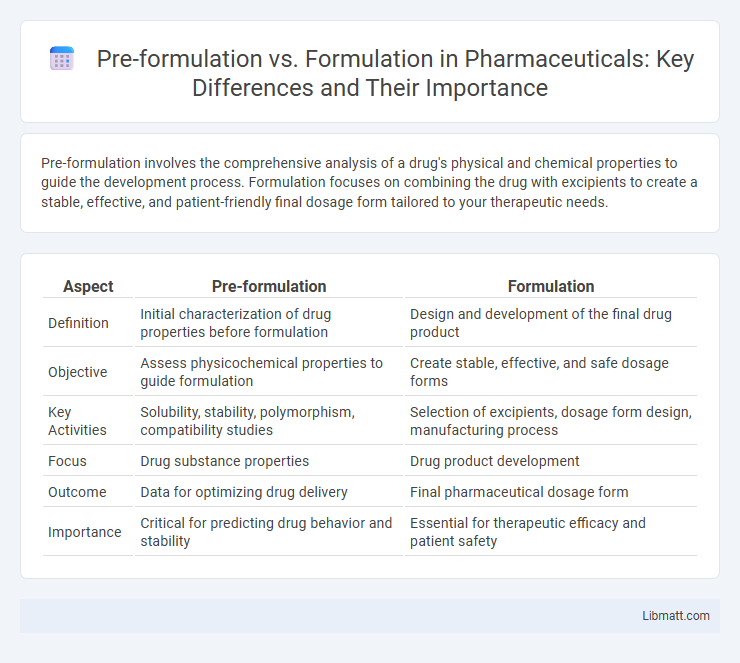Pre-formulation involves the comprehensive analysis of a drug's physical and chemical properties to guide the development process. Formulation focuses on combining the drug with excipients to create a stable, effective, and patient-friendly final dosage form tailored to your therapeutic needs.
Table of Comparison
| Aspect | Pre-formulation | Formulation |
|---|---|---|
| Definition | Initial characterization of drug properties before formulation | Design and development of the final drug product |
| Objective | Assess physicochemical properties to guide formulation | Create stable, effective, and safe dosage forms |
| Key Activities | Solubility, stability, polymorphism, compatibility studies | Selection of excipients, dosage form design, manufacturing process |
| Focus | Drug substance properties | Drug product development |
| Outcome | Data for optimizing drug delivery | Final pharmaceutical dosage form |
| Importance | Critical for predicting drug behavior and stability | Essential for therapeutic efficacy and patient safety |
Introduction to Pre-formulation and Formulation
Pre-formulation involves the comprehensive analysis of drug properties such as solubility, stability, and compatibility, which are essential for informing the design of an effective pharmaceutical dosage form. Formulation uses this pre-formulation data to develop a stable, bioavailable medication that meets regulatory standards and patient needs. Understanding the distinction between pre-formulation and formulation ensures your drug development process is efficient and scientifically sound.
Understanding Pre-formulation: Key Concepts
Pre-formulation involves the systematic study of a drug's physical and chemical properties to ensure optimal stability, solubility, and bioavailability before formulation development. Key concepts include analyzing polymorphism, pKa, partition coefficient, and compatibility with excipients to predict the drug's behavior in biological systems. This critical phase guides the selection of appropriate formulation strategies to enhance drug efficacy and patient compliance.
The Formulation Process: An Overview
The formulation process involves combining active pharmaceutical ingredients (APIs) with excipients to create a stable, effective, and deliverable drug product. Pre-formulation studies assess the physical and chemical properties of APIs to guide formulation design, ensuring optimal bioavailability and stability. Your understanding of both stages is crucial for developing safe and effective medications.
Objectives of Pre-formulation in Drug Development
Pre-formulation in drug development focuses on evaluating the physical and chemical properties of the active pharmaceutical ingredient (API) to ensure stability, solubility, and bioavailability, which are critical for effective drug formulation. Understanding parameters such as polymorphism, hygroscopicity, and pH stability enables the design of suitable delivery systems and dosage forms. Your ability to optimize these factors early in pre-formulation improves the likelihood of successful formulation development and regulatory approval.
Critical Steps in Formulation Science
Critical steps in formulation science include the selection of appropriate excipients, understanding drug-excipient compatibility, and optimizing physical and chemical stability. Pre-formulation studies provide essential data on solubility, pH stability, and polymorphism, which guide the formulation design process. These steps ensure bioavailability, efficacy, and safety of the final pharmaceutical product.
Comparative Analysis: Pre-formulation vs Formulation
Pre-formulation involves the characterization of drug properties such as solubility, stability, and bioavailability to ensure optimal drug design, whereas formulation focuses on the practical development of the final drug product including the selection of excipients and dosage form. Pre-formulation data guides formulation scientists in creating effective, safe, and stable medication by predicting how the drug interacts with various components. Your understanding of the comparative analysis between pre-formulation and formulation is essential for developing pharmaceuticals that meet regulatory standards and therapeutic efficacy.
Importance of Pre-formulation Data for Formulation Design
Pre-formulation data provides critical insights into the physicochemical properties of a drug candidate, enabling precise formulation design tailored to enhance stability, solubility, and bioavailability. This foundational analysis reduces development risks by identifying potential compatibility issues with excipients and guiding the selection of appropriate delivery systems. Leveraging comprehensive pre-formulation studies streamlines formulation optimization, ensuring effective therapeutic performance and regulatory compliance.
Challenges in Pre-formulation and Formulation
Challenges in pre-formulation primarily involve assessing the physicochemical properties of a drug candidate, such as solubility, stability, and bioavailability, to ensure compatibility with excipients and predict in vivo performance. In formulation, difficulties arise in optimizing dosage forms for controlled release, patient compliance, and scaling up manufacturing processes while maintaining consistency and efficacy. Your product's success depends on overcoming these complex challenges to achieve a stable and effective pharmaceutical formulation.
Technological Advances in Pre-formulation and Formulation
Technological advances in pre-formulation include high-throughput screening, advanced analytical techniques like NMR and mass spectrometry, and in silico modeling to predict physicochemical properties and optimize drug stability. In formulation, innovations such as nanotechnology, 3D printing, and controlled-release systems enhance drug delivery efficiency and patient compliance. These technological improvements allow Your pharmaceutical development process to be more precise, reducing trial-and-error and accelerating time-to-market.
Future Trends in Pharmaceutical Pre-formulation and Formulation
Future trends in pharmaceutical pre-formulation emphasize advanced analytical techniques such as AI-driven predictive modeling and high-throughput screening to optimize drug solubility, stability, and bioavailability. Formulation development is increasingly adopting nanotechnology, personalized medicine approaches, and sustained-release mechanisms to enhance therapeutic efficacy and patient compliance. Integration of continuous manufacturing processes with real-time quality monitoring is revolutionizing scalability, regulatory compliance, and cost-effectiveness in both pre-formulation and formulation stages.
Pre-formulation vs Formulation Infographic

 libmatt.com
libmatt.com